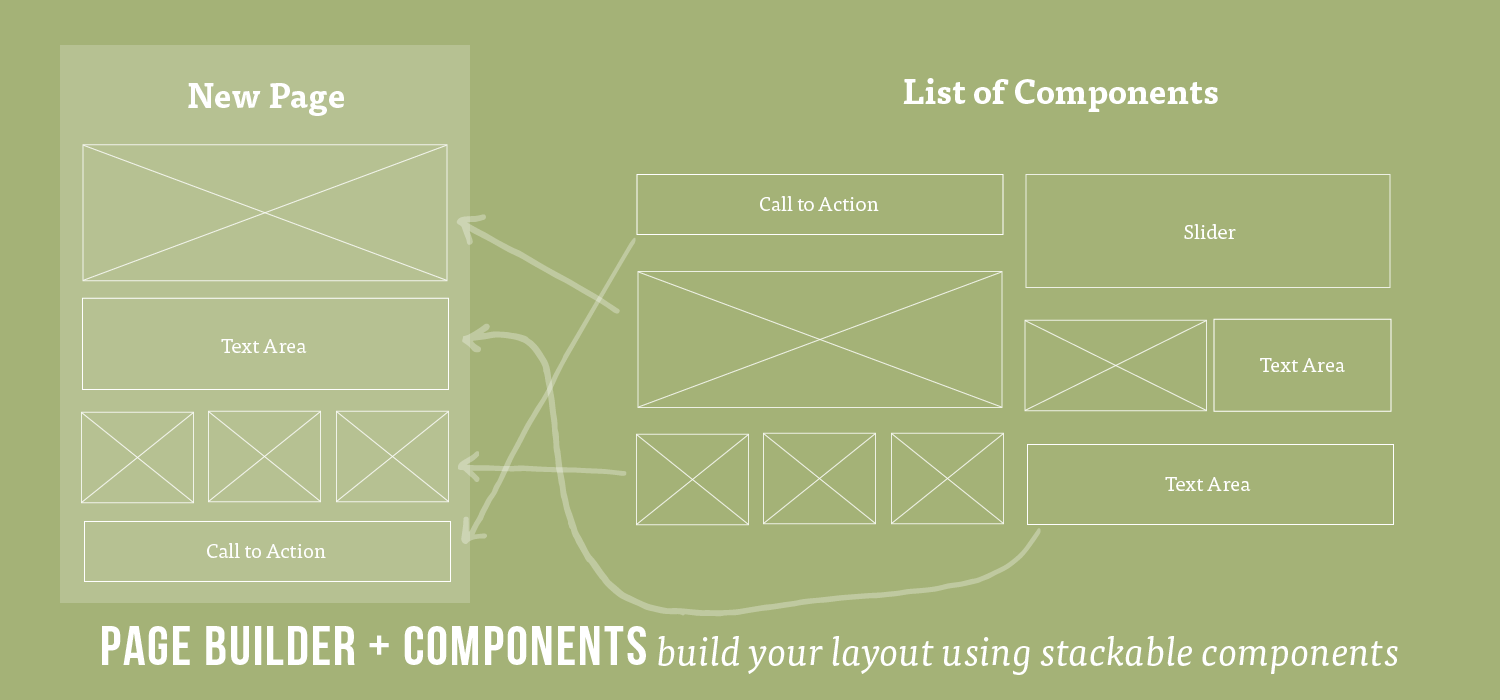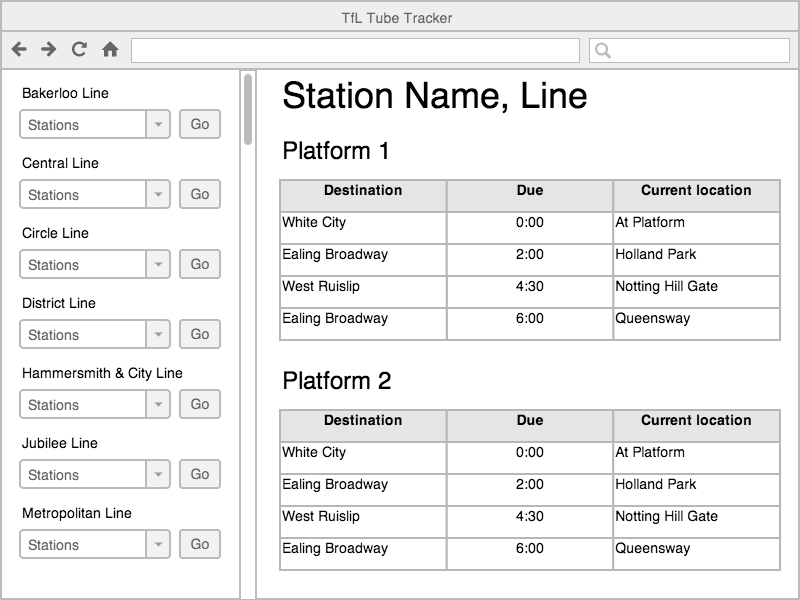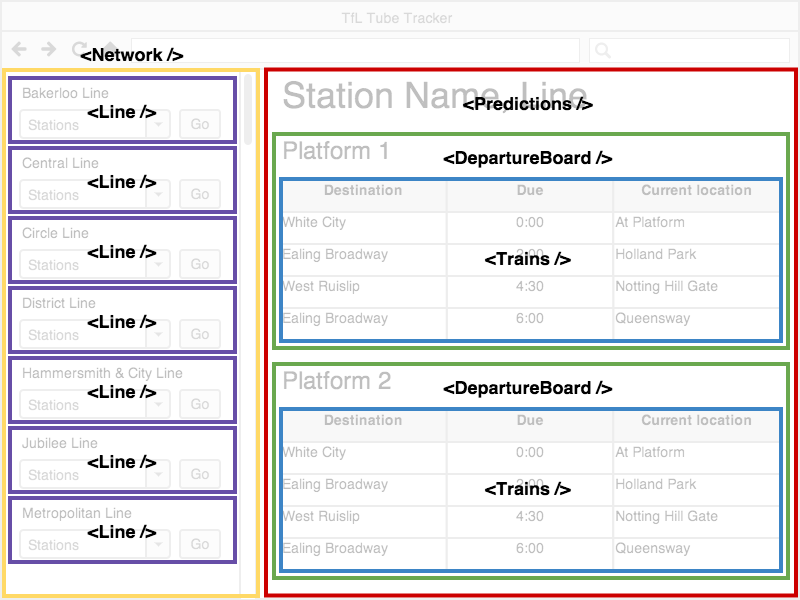React Components
We saw a bit of how react works, and how babel works with react.
Now we will see one of the main concepts of React, the Component.
In the last example we saw that we can use react to render things just like we did in express and rails- where the HTML template is a kind of code mad-lib- You fill in the data where it needs to go in the page.
React does this at the base level, but we can also sub-divide each part of a page into Components.
These are the sepearate logical pieces of any page.

Figure: https://github.com/wdi-sg/react-intro/raw/master/images/templates-page.png


Figure: https://github.com/wdi-sg/react-intro/blob/master/images/components-page.png


Figure: https://github.com/wdi-sg/react-intro/blob/master/images/wireframe.png


Figure: https://github.com/wdi-sg/react-intro/blob/master/images/wireframe_deconstructed.png

Properties of Components
- separation of concerns
- nested / pass data down from parent
- F focused
- I independant
- R resuable
- S small
- T testable
Babel standalone
Before we move to writing code, let's talk about the default tool we'll use until we learn the React build tools.
<script src="https://unpkg.com/babel-standalone@6/babel.min.js"></script>
<script type="text/babel">
ReactDOM.render(
<p>hello world!</p>,
document.getElementById('root')
);
</script>
babel-standalone relies on a script tag type text/babel. It ingests everything inside that script tag, transpiles it and evals it.
Writing a component
class List extends React.Component {
render() {
return (
<ul>
<li>Hello world</li>
</ul>
);
}
}
ReactDOM.render(
<List />,
document.getElementById('root')
);
Listis a js "class" that inherits from React- a component has certain methods like
renderthat allow you to control it
Component Properties
In react, a component takes data in and renders itself based on that data.
The data is passed from above in the parent component.
Let's start rendering a real list from data coming from outside the list itself.
class List extends React.Component {
render() {
let itemsElements = this.props.items.map(item => {
return <li>{item}</li>
});
return (
<ul>
{itemsElements}
</ul>
);
}
}
const listOfItems = [
"apples",
"bananas",
"pineapple"
];
ReactDOM.render(
<List items={listOfItems} />,
document.getElementById('root')
);
Props
Props are the react way of passing data into your component.
When you specify your component you specify it's props just like an HTML attribute.
<List items={listOfItems} />
You can then access them from within the component using this.props
Nesting Components
We mentioned that it's the nested structure of components using components that really makes react special.
Let's put our <li> tag data in it's own component.
class ListItem extends React.Component {
render() {
return (
<li>{this.props.item}</li>
);
}
}
class List extends React.Component {
render() {
let itemsElements = this.props.items.map( (item, index) => {
return <ListItem item={item}></ListItem>;
});
return (
<ul>
{itemsElements}
</ul>
);
}
}
const listOfItems = [
"apples",
"bananas",
"pineapple"
];
ReactDOM.render(
<List items={listOfItems} />,
document.getElementById('root')
);
Exercise
Run the above code: create a component that gets rendered multiple times by passing in props.
Don't forget to include the 3 libraries you need:
<script src="https://unpkg.com/react@16/umd/react.development.js"></script>
<script src="https://unpkg.com/react-dom@16/umd/react-dom.development.js"></script>
<script src="https://unpkg.com/babel-standalone@6/babel.min.js"></script>
Create a separate jsx file to put your code in and create a script tag to go with it.
<script src="script.jsx" type="text/babel"></script>
Chrome will require that you get your file from the network (localhost) - so you will have to run http-server in your current directory in order to get the file to be loaded and executed from the script tag.
Further
Have the list item class render 2 components: ItemId which will use the map index (from the above example) as the id, and Item which will render the text of the item. Pass data into these two components as props.
Further
var fruits = [
{
name:"apple",
weight:23,
colors : [
"red","green","yellow"
]
},
{
name:"mango",
weight:13,
colors : [
"green","yellow"
]
},
{
name:"avocado",
weight:3,
colors : [
"green","brown"
]
}
];
Create react code that renders this array of objects.
Use at least 2 separate components.